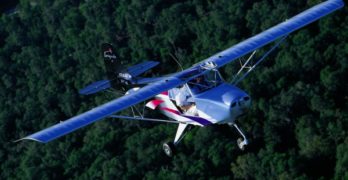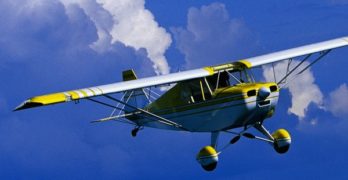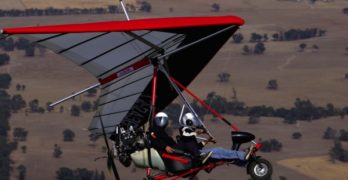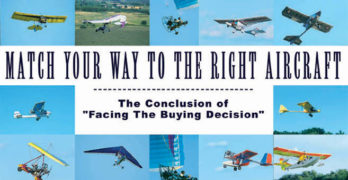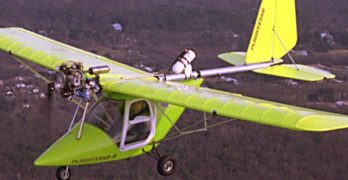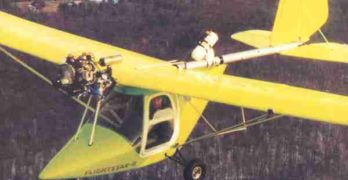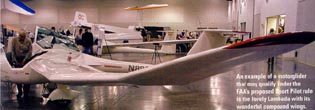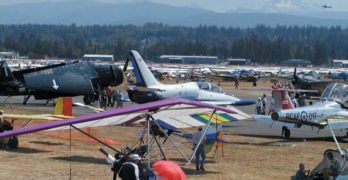Just Aircraft’s Excapade … certificated in England and ready for sport pilots!
Southwestern Idaho has long been a hub of aircraft activity. With ranches and towns settled in great distances, it’s not surprising that aviation, once an established mode of transportation, quickly became popular in that part of the west. It’s also not surprising, then, that the area has been a hub of aircraft building activity. Here’s the story of one aircraft that’s evolved from that heritage.
In 1983, a two-seat, steel tube and fabric aircraft called the Avid Flyer made its first appearance at EAA’s annual convention. Describing the new design in the October 1983 issue of EAA Sport Aviation, then editor Jack Cox wrote, “Dan Denney of Boise, Idaho, was the person with the idea from which sprang the Avid Flyer. He wanted ‘something between ultralights and homebuilts’|(and) Dan had a friend uniquely qualified to transform that (idea) into|an airplane, Dean Wilson.”
What Denney and Wilson demonstrated to the fly-in crowd that year might be called the forerunner of the pending light-sport aircraft category|even at a time when ultralights were still gaining their foothold.
Search Results for : four-stroke
Not finding exactly what you expected? Try our advanced search option.
Select a manufacturer to go straight to all our content about that manufacturer.
Select an aircraft model to go straight to all our content about that model.
Product Lines – March 1998
ST. PAUL, MN — Back home in the not-so-cold north (with a surprising "thanks" to El Nino), the year started off with some unhappy news. ••• In mid-January, Acme Glider Company boss Terry Reynolds wrote all TR3 owners and other interested parties. "We have given it our best and we just cannot go on any longer. We have to cease operations," he expressed. • After facing the true cost of building his exotic glider in small volume Terry concluded, "There is no chance that we can charge enough to cover reasonable costs of production and distribution at present volumes." Acme says the TR3 had direct manufacturing costs of $8,000 per glider, before accounting for R&D payoff, office expenses, and any other non-manufacturing expenses. • Acme made arrangements with Lookout Mountain’s Matt Taber to provide future support for their gliders. "Matt has assured us that he is wholeheartedly enthusiastic in taking on this project," the company reported.
Product Lines – August 1996
ST. PAUL, MINN — Airshow season is here. About the same time we hang glider pilots are heading out to sites across the country to catch the big thermals of summer, millions of non-pilots (and pilots) will attend local-area airshows. They’re America’s second largest public spectator event after baseball, quite a statement in a country known around the globe for having countless choices of entertainment. At how many of those airshows will the millions see hang gliding? Darn few! ••• One man is changing that by succeeding as few before him have done. Dan Buchanan performs despite physical challenges (a vehicle accident if you don’t know Dan’s story). He was able to fly the main airshow at Oshkosh last year, no small feat since the Wisconsin convention is one of the world’s largest events with close to a million people attending. Some pilots have waited literally years to get in, that is, to volunteer to perform; no pay is offered.
Hawk looks Good in Wood!
Not all Light-Sport Aircraft will be composite.
Beautiful imported aircraft like the CT2K, Mirage, Jabiru, or Kolb Sport seem to best represent what many pilots imagine when they hear the words “light-sport aircraft.” These shapely composite designs are speedy and modern looking. Yet we’d be foolish to ignore the entire fleet of amateur-built light-sport aircraft (LSA) candidates. One of these is Fisher Flying Products’ Dakota Hawk.
Wood Still Works!
The Dakota Hawk is a simple, wood-structure light aircraft covered in fabric. Sound familiar? Sound comfortable and well understood? You bet it does.
While the Dakota Hawk may not be seen as a “modern” design, neither is it a vintage aircraft like Fisher’s fascinating Tiger Moth replica. Instead, most pilots probably link the Dakota Hawk to a golden era of general aviation when Piper Cubs, Taylorcrafts, and Luscombes were the darlings of light flight.
Regardless of what regulatory program it operates under, this high-wing taildragger is a sweet flier that will address what many pilots want out of aviation.
Simple Done Right
AirBorne’s Outback trike has all the essentials
Light-sport aircraft (LSA) are on the minds of many would-be sport pilots, especially now that the proposed rule has advanced from the Depart-ment of Transportation (DOT) to the Office of Management and Budget (OMB) for its last review. But the big-picture view of these airplanes is complex. Yes, we’ll have sleek im-ported machines like the CT2K, G3 Mirage, SkyBoy, or SportStar, but we’ll also have much more. We will also still have popular American-made machines like Zenith’s CH 601, SkyStar’s Kitfox, Quicksilver’s MX or GT series, RANS’ Coyotes, Quad City Ultralight’s Challenger, and more. And we’ll have trikes, powered para-chutes, gliders, airships, gyros, and who-knows-what-else. The new LSA category actually represents a virtual zoo of different aerial animals. The fiberglass or metal versions that may enter our market from Europe are but the upper end of the spectrum, in both speed and price.
Trikes, in particular, may be one of the earlier qualifying entries.
How-to-Buy a Lightplane — Part 3 of 3
In the previous two installments, we’ve discussed you, the pilot, and the many types of aircraft choices you have. As we wrap up this series, we’ll put it all together and try to help you narrow your choices to a few models.
Notice the word “try.” It is important that you understand that it is not possible to direct you to the one-and-only best choice of aircraft. Novice buyers often seek assistance but even experienced pilots can become swayed and end up purchasing the wrong aircraft for their needs and desires. Because aircraft purchases are commonly emotional decisions, it is helpful to gain a “second opinion” to help make a more rational choice.
Many years ago, at the beginning of my career writing articles in light aviation, I made a similar attempt to help hang glider pilots choose the right glider. I compared nine contemporary models to an idealized “perfect” glider and through a series of questions much like those below, tried to steer pilots to the one right glider for them.
The First Two Ultralights with the New HKS Engine
It isn’t often I can do “scouting party” duty on engines. Powerplants aren’t normally my focus. They
are a necessity for flight, but they aren’t my main attraction. A great many pilots I’ve met appear to be just the reverse: They are extremely interested in engines.
I enjoyed the chance to fly behind the first European and first American installations of the new 60-hp HKS 700E 4-stroke from Japan’s HKS Company Ltd. With that in mind, this pilot’s report is rather different. We’ll look at this new engine on two different aircraft.
As all Ultralight Flying! readers know, Rotax has enjoyed great success for more than a decade as an ultralight engine supplier. After dominating the 2-stroke market, Rotax introduced the 81-hp Rotax 912 4-stroke, which has become a popular powerplant choice for sport aviation aircraft.
Is a 4-Stroke Better?
All 4-stroke engine manufacturers trumpet their advantages over 2-strokes: lower fuel consumption, quieter operation, longer time between overhaul, and reliability.
Flightstar Inc. — Flightstar II + HKS Engine
Daring to take on deeply entrenched Rotax, Flightstar/H-Power has introduced the first light aviation four-stroke engine to see broad acceptance. Joined with their smoothly contoured Flightstar II, you can have a deluxe ultralight or lightplane that will provide years of flying enjoyment.
While two strokes do the job for most ultralight enthusiasts, the four stroke 700E engine from HKS of Japan offer assurances some pilots demand. With its particular strength of mid-range torque, the HKS engine brings interesting differences. Pull up the nose while revolutions are set in the 4000s and the HKS will haul the Flightstar II aloft with no evidence of prop loading common among two stroke engines.
Flightstar still sells lots of their very popular IISL models, but on this lighter aircraft, they recommend the Rotax 503. However, now that the same company has adapted the stronger HKS engine, sales are soaring for their Flightstar II with its beautifully formed all-fiberglass cockpit enclosure.
AirSports Expo 2002
AirSports Expo attracts a large crowd and many vendors.
On the first day in Ontario, California, you could see this was going to be the largest AirSports Expo yet. In the shadow still lingering from September 11, many wondered and worried about participation and attendance, but the concern was baseless. A flurry of activity in the last few weeks before the show brought so many requests for exhibit space that the already designed floor plan had to be scrapped and redrawn.
More than 2200 pilots and other visitors saw the exhibits of 65 vendors. While still small next to Sun ’n Fun or AirVenture Oshkosh, this was a good turnout. The range of vendors included many aircraft suppliers and all manner of accessories and informational products.
Gathering of Eagles
AirSports Expo represents the combined efforts of the Soaring Society of America (SSA), the U.S. Ultralight Association (USUA), and the U.S. Hang Gliding Association (USHGA).
New Aircraft Arrive at Arlington
With 200-foot-tall trees and mountain peaks topped with snow throughout the year, Washington is a scenic place for an airshow. Despite a drought that caused the grass to crunch underfoot, light aviation looked alive and well at the EAA’s Arlington gathering for 2003.
Local Boys Make Good
One main attraction was the much-anticipated RV-10 four-place aircraft that drew big crowds. But a Washington-area group also revealed their efforts of past months. Sport Flight Aviation displayed in the ultralight area with the first of 50 kits in progress. Two completed Talons—the last of the old design—stood alongside a new Typhoon. The new closely resembles the old.
Company owners Todd Thompson and Ron Osborne took pride in showing me extensive CAD-generated drawings printed after a lengthy effort to document the popular northwest design. Each of the men operates a non-aviation business. They teamed up to resuscitate a company left leaderless after the death of its founder, Roger Bitton.
- « Previous Page
- 1
- …
- 8
- 9
- 10
- 11
- 12
- 13
- Next Page »


